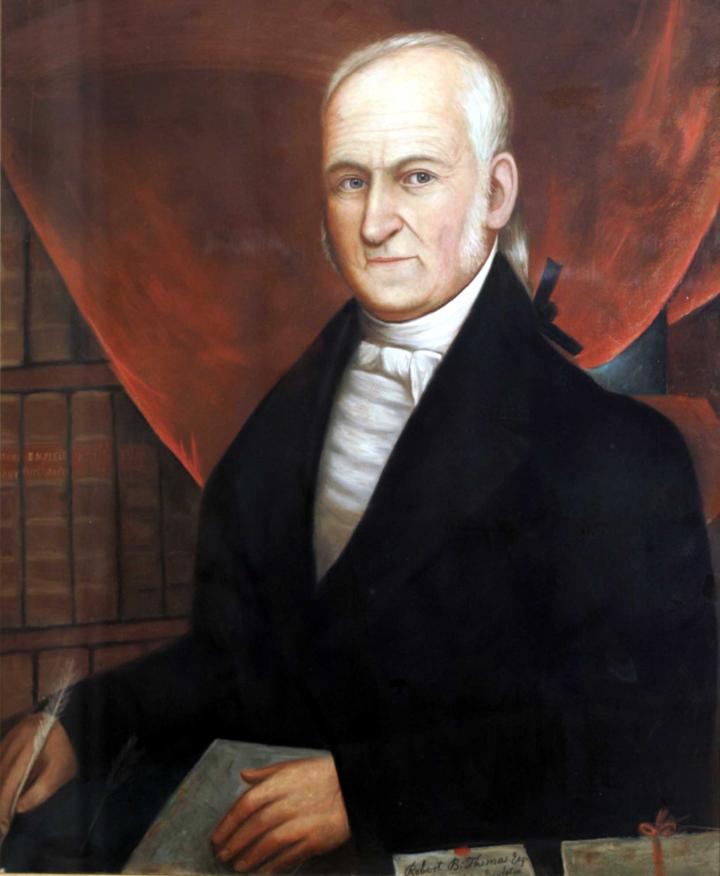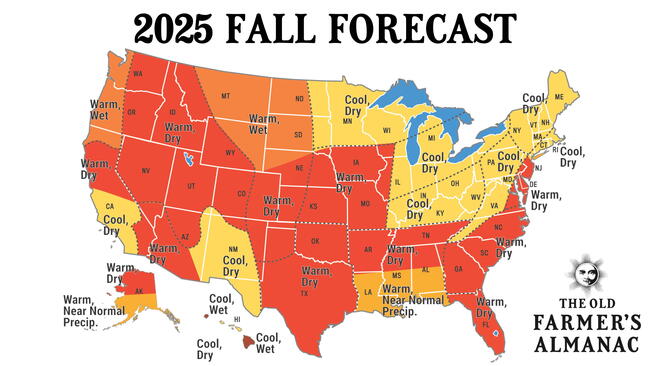America’s oldest weather forecaster, The Old Farmer’s Almanac, specializes in predicting extended forecasts.
Why are we so interested in long-range weather? Originally a calendar for farmers and gardeners to plan for the year ahead, the Almanac is a tool revered by anyone who watches the weather—from outdoor enthusiasts, travelers, and economists to truckers, shippers, and skywatchers—and everyone in between.
Read on to learn about our unique, age-old formula that’s based on three scientific disciplines and to ponder these key questions:
- What’s normal weather?
- How does climate change factor into our forecasts?
- What role does weather lore play?
New! Read about our 2025—2026 Winter Forecast!
A Secret Weather Formula
The Old Farmer’s Almanac has predicted the weather since our founding in 1792—when George Washington was president and actively farming at Mount Vernon. (Fun fact: One of Washington’s greatest preoccupations during his agricultural career was to eschew single crop farming; in 1785–86, his diaries mention planting barley, clover, corn, carrots, cabbage, flax, millet, oats, peas, potatoes, spelt, turnips, and wheat, among other crops.)
Our weather forecast methodology stems from a formula devised by our founder, Robert B. Thomas. Thomas believed that Earth’s weather was influenced by sunspots, which are magnetic storms on the surface of the Sun, and this factored heavily in his forecasts.
Over the years, we have refined and enhanced Thomas’s formula with state-of-the-art technology and modern science.

We Use 3 Disciplines in Long-Range Predictions
We predict weather trends and events by comparing solar patterns and historical weather conditions with current solar activity. We employ three disciplines to make our long-range predictions:
- solar science, the study of sunspots and other solar activity;
- climatology, the study of prevailing weather patterns; and
- meteorology, the study of the atmosphere.
Like all forecasters, we have not yet gained sufficient insight into the mysteries of the universe to predict the weather with total accuracy, though our results are often very close to our traditional claim of 80 percent.

What Is “Normal” Weather?
The weather predictions in our almanac (and any other forecast for that matter) compare temperature and precipitation levels to “normal.” Our forecasts consider normal to be the 30-year average.
Every 10 years, the National Center for Environmental Information calculates a new set of normal temperatures for the U.S. based on updated 30-year averages. Starting with the 2023 edition of The Old Farmer’s Almanac, the long-range predictions have been based on the 30-year time frame from 1991 to 2020 (previously, data was drawn from 1981 to 2010). Environment Canada released their new “normal” data in the fall of 2024, which provided more insight into North American trends.
The recalibrated data for the U.S. shows that warming is widespread, but not uniform. Warmer temperatures are not occurring everywhere at the same time of year, either. An example is how the first half of the year has been cooler than normal on average in the north-central U.S. over the past decade. As for precipitation, the eastern regions of the U.S. are now generally wetter than in the past, and intense rain events are more common.
Read more about how our climate normals are calculated.
How Does Climate Change Factor into Our Forecasts?
Climate change is factored into our long-range weather forecasting, especially when it comes to temperatures. We make predictions based partly on historical data, then adjust temperature predictions to be warmer, but not uniformly: polar regions are warming faster than lower latitudes over the past several decades.
Overall, there are fewer colder winters than there were 50 years ago, and it’s rarer to get prolonged cold; we still see extreme cold, and even very cold months, yet less and less are we seeing—and forecasting—multiple consecutive weeks of temperatures staying solidly 5 to 6 degrees below average.
In addition, there are geographic pockets where seasons, and temperatures, lag: The Canadian Prairies and Great Lakes are experiencing more winter “hangovers”—when winter weather is more pronounced later in the season, such as February and March, and into April.
Likewise, there’s a summer hangover effect in the northeast and mid-Atlantic regions, with summer weather extending into September and October.
We also use climate signals, called teleconnections, to help make our long-range weather forecasts. These links between weather phenomena at different locations on Earth affect climate patterns spanning thousands of miles—think El Niño/La Niña. Due to climate change, teleconnections can change over time, and may not be as effective as they were in the past. We constantly monitor these teleconnections to determine their effectiveness while also looking out for new teleconnections that can develop over time.
What’s Lore Got to Do With It?
Some think our long-range forecasts are derived from folklore. According to weather lore, a long, hard winter can be predicted by lots of acorns, tough apple skins, and thick corn husks, while a mild one can be predicted by lower bees’ nests and thin onion skins. A persimmon seed may give you clues, too!
While we can neither confirm nor deny the reliability of this folklore, we do know that, centuries ago, folks observed such phenomena and noticed corresponding weather patterns, so at The Old Farmer’s Almanac, we allow that there just might be some truth to it! However, folklore does not figure into creating weather forecasts in our annual almanac.
Where You Can Buy The Old Farmer’s Almanac
The 2026 Old Farmer’s Almanac—America’s #1 Almanac—is now available to order in classic paperback, hardcover, and digital editions!
Always reliable and entertaining, this handy yellow book is a “true” Almanac—a calendar of the heavens, a time capsule of the year, and an essential reference that reads like a magazine. Always timely, topical, and distinctively “useful, with a pleasant degree of humor,” the Almanac is useful DAILY in all walks of life.
Now in its 234th year, The Old Farmer’s Almanac is STILL the best-selling annual in the United States and Canada, thanks to readers from coast to coast! The longest-running periodical in America (since George Washington was president!), it’s a timeless guide to daily living. With our long-standing commitment to “new, useful, and entertaining matter,” you can count on your new edition to deliver a comprehensive and trustworthy guide to 2026.
Order the 2026 Almanac exclusively in our Almanac.com store or on Amazon!













Comments